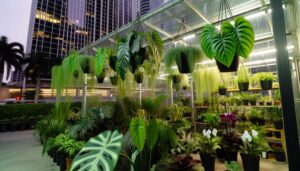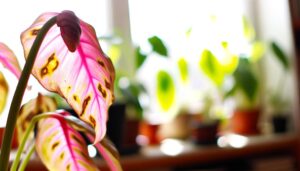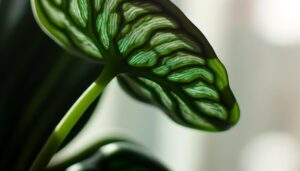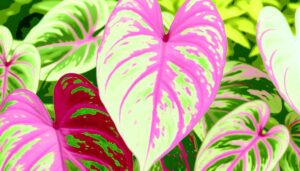What Is Thaumatophyllum Spruceanum (Philodendron Goeldii)?
Thaumatophyllum spruceanum, formerly known as Philodendron goeldii, is a species originating from the Amazon Basin's tropical rainforests. It features deeply lobed, glossy green leaves arranged in a rosette pattern, with each lamina reaching up to 50 cm long.
The plant exhibits a clumping growth pattern, forming dense clusters with thick, semi-woody caudex stems. Optimal growth occurs under bright, indirect sunlight and consistently moist, well-draining soil.
Its rhizomatous root system aids in its resilience and adaptability. The species' taxonomic reclassification and unique botanical characteristics make it a fascinating subject for horticultural enthusiasts.
Continue exploring its specifics for thorough insights.
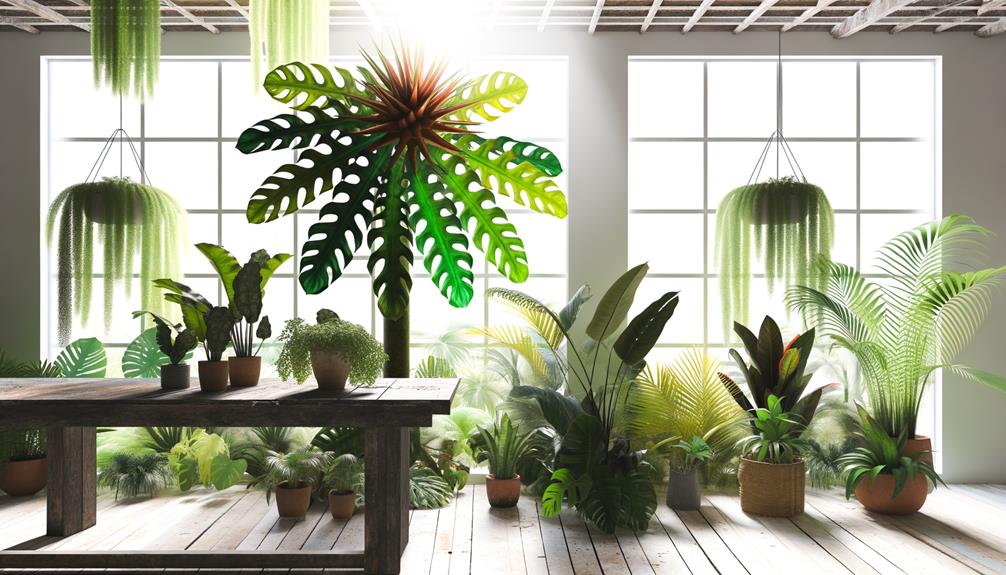
Key Takeaways
- Thaumatophyllum spruceanum is a tropical plant originating from the Amazon Basin.
- It was previously known as Philodendron goeldii before taxonomic reclassification.
- The plant features deeply lobed, glossy green leaves in a rosette-like arrangement.
- It thrives in bright, indirect sunlight and prefers consistently moist, well-draining soil.
- Known for its aesthetic appeal, it is popular in horticulture for its adaptability.
Origins and History
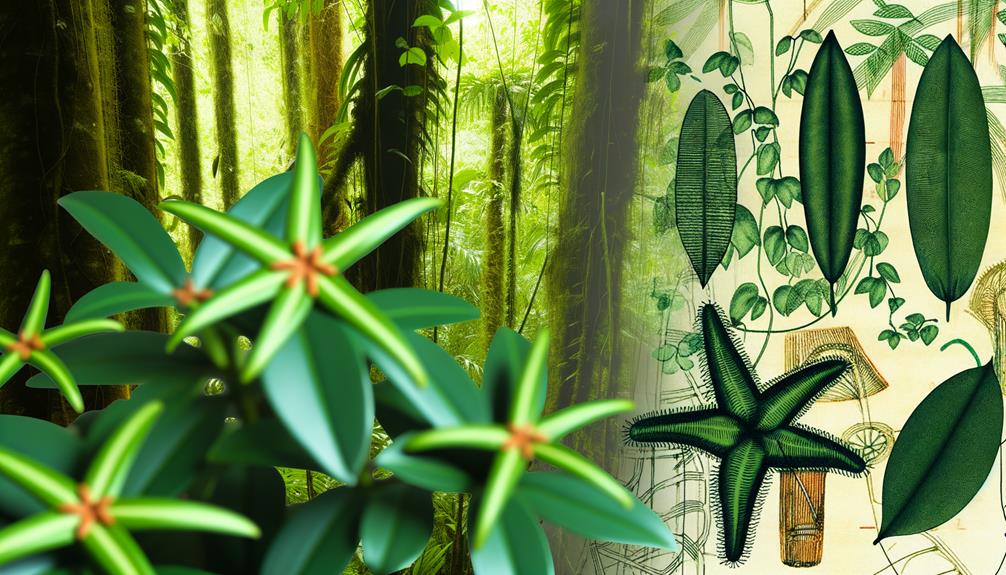
Thaumatophyllum spruceanum, formerly classified under the genus Philodendron as Philodendron goeldii, traces its origins to the tropical rainforests of the Amazon Basin, specifically thriving in the ecosystems of Brazil, Colombia, and Peru. This taxonomic reclassification arose from phylogenetic studies revealing distinct genetic lineages.
Thaumatophyllum spruceanum's habitat is characterized by high humidity, perennial rainfall, and rich, loamy soils, which contribute to its robust growth. Historically, indigenous communities have utilized this plant for various ethnobotanical purposes, leveraging its natural properties. The species was first described by botanists during the 19th century, with its distinct morphological features capturing scientific interest.
Over time, it has become a subject of horticultural fascination, valued for its adaptability and aesthetic appeal in tropical plant collections.
Botanical Characteristics
Characterized by its distinctive rosette-like arrangement of petioles and deeply lobed, glossy green leaves, Thaumatophyllum spruceanum exhibits a unique morphology that differentiates it from other members of the Araceae family.
The leaves, scientifically termed as laminae, are typically pinnatifid, displaying multiple lobes that can extend up to 50 cm in length. The petioles, or leaf stalks, are robust and can reach a length of 30 cm, providing structural support.
This species features an inflorescence known as a spadix, surrounded by a spathe, typical of Araceae. The plant's stem, referred to as the caudex, is thickened and often exhibits a woody texture.
These botanical characteristics make Thaumatophyllum spruceanum distinct within its genus and highly recognizable.
Growth Patterns
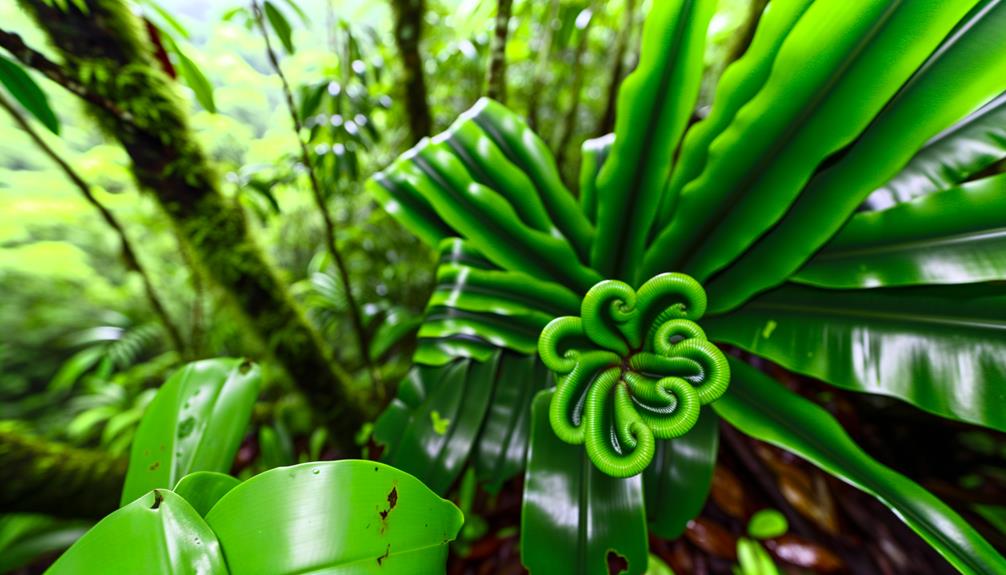
In its natural habitat, Thaumatophyllum spruceanum displays a clumping growth pattern, with individual stems emerging from a central base and gradually extending outward.
This perennial species, also known as Philodendron goeldii, forms dense clusters, allowing it to create a substantial foliage mass. The stems are robust and semi-woody, supporting large, palmate leaves that can reach up to 60 cm in length.
Each leaf is characterized by multiple lobes, giving a distinctly tropical appearance. The plant's growth rate is moderate, and it tends to spread horizontally rather than vertically, making it ideal for ground cover in tropical and subtropical regions.
Importantly, Thaumatophyllum spruceanum's rhizomatous root system contributes to its resilience and ability to thrive in diverse soil conditions.
Light Requirements
Thaumatophyllum spruceanum, commonly known as Philodendron Goeldii, exhibits peak growth under conditions of bright, indirect sunlight, which mirrors its natural understory habitat.
While this species is adaptable and can tolerate lower light levels, providing filtered light is crucial for maintaining its foliage vibrancy and overall health.
Excessive direct sunlight can cause chlorosis and leaf burn, requiring careful placement to guarantee appropriate light exposure.
Indirect Sunlight Preferred
Philodendron goeldii, commonly known as Thaumatophyllum spruceanum, thrives under conditions of bright, indirect sunlight, which is crucial for its best growth and development. This species, originating from the understory of tropical rainforests, is adapted to receive filtered light through the forest canopy. A well-lit environment without exposure to direct sunlight helps maintain prime photosynthesis while preventing leaf scorch.
Benefits of indirect sunlight include:
- Enhanced Photosynthesis: Ensures efficient energy conversion while safeguarding delicate leaf tissues.
- Vibrant Foliage: Maintains the characteristic lush, green appearance of Thaumatophyllum spruceanum.
- Robust Growth: Promotes healthy leaf development and overall plant vigor.
Securing these light conditions will allow Thaumatophyllum spruceanum to flourish, replicating its natural habitat's dappled light environment.
Tolerates Low Light
Despite its preference for bright, indirect sunlight, Thaumatophyllum spruceanum exhibits remarkable adaptability, tolerating lower light conditions without significant harm to its growth. This resilience is attributed to its strong physiological mechanisms, which enable efficient photosynthesis even under less than ideal lighting.
The chlorophyll-rich leaves maximize light absorption, facilitating energy production in dim environments. However, prolonged exposure to low light may result in slower growth rates and diminished leaf variegation. Thaumatophyllum spruceanum's capability to endure low light makes it an ideal choice for indoor settings, where natural light may be limited.
It is important to monitor its condition, ensuring occasional exposure to indirect sunlight to maintain peak health and vigor. Regular rotation can prevent asymmetrical growth and foliage loss.
Watering Needs
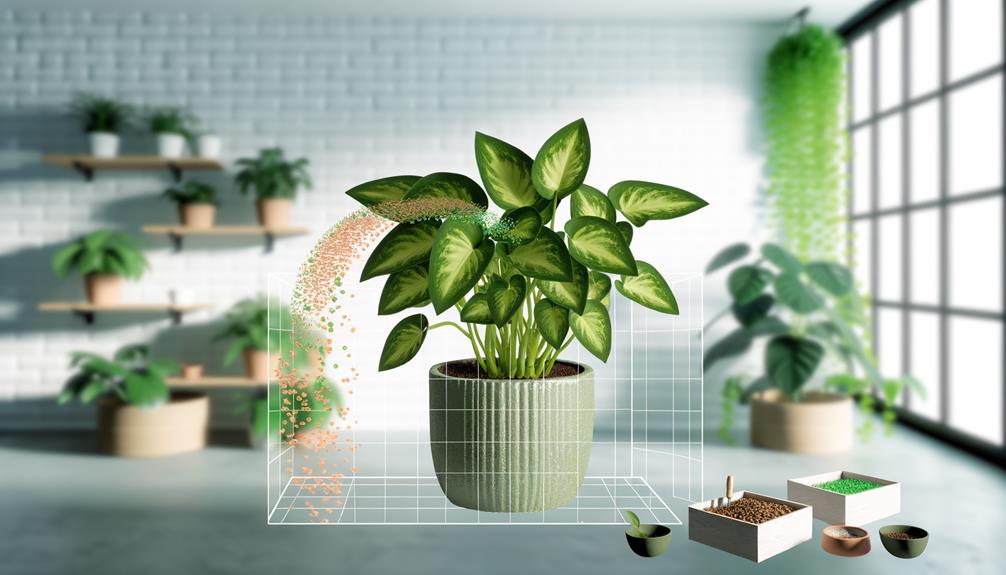
Proper irrigation of Thaumatophyllum spruceanum requires a thorough understanding of its natural habitat and water consumption patterns. Native to tropical rainforests, this species thrives in consistently moist yet well-draining environments. Achieving an ideal balance between hydration and aeration is essential for its health.
Consider these key watering principles:
- Consistency: Maintain steady moisture, avoiding both drought and waterlogging.
- Water Purity: Utilize rainwater or distilled water to prevent mineral buildup.
- Moisture Levels: High ambient humidity (60-80%) enhances hydration and mimics native conditions.
Monitoring soil moisture levels with a hygrometer can prevent overwatering, which may lead to root rot. Allow the top inch of soil to dry before rewatering. This approach ensures the Thaumatophyllum spruceanum sustains robust growth and vibrant foliage.
Soil and Fertilization
Securing optimal growth for Thaumatophyllum spruceanum necessitates a well-draining soil mix abundant in organic matter, such as a combination of peat moss, perlite, and pine bark. This blend offers aeration while maintaining necessary moisture. Fertilization should be approached with a balanced, water-soluble fertilizer, applied bi-monthly during the growing season. Utilizing a formulation with an N-P-K ratio of 20-20-20 guarantees an even distribution of essential nutrients.
| Soil Component | Function |
|---|---|
| Peat Moss | Retains moisture and nutrients |
| Perlite | Improves aeration and drainage |
| Pine Bark | Boosts organic matter |
| Balanced Fertilizer | Provides essential nutrients (N-P-K 20-20-20) |
This meticulous care in soil and nutrient management is crucial for the flourishing of Thaumatophyllum spruceanum.
Common Pests and Diseases
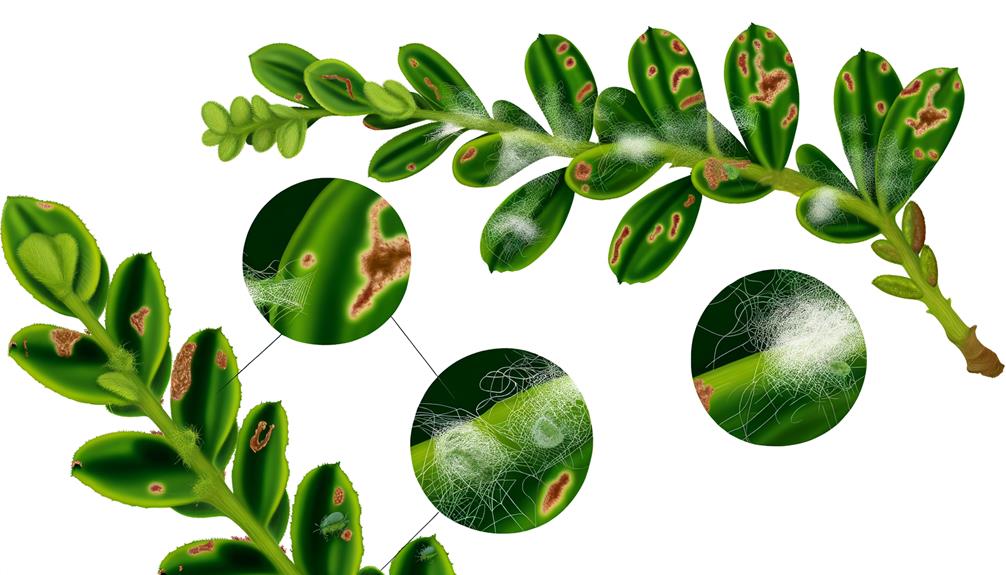
Thaumatophyllum spruceanum, like many aroid species, is susceptible to various pests and diseases, including spider mites (Tetranychidae), mealybugs (Pseudococcidae), and bacterial leaf spot (Xanthomonas campestris).
Spider mites cause stippling and webbing on leaves, often leading to chlorosis. Mealybugs excrete honeydew, promoting sooty mold and weakening plant vigor. Bacterial leaf spot manifests as water-soaked lesions that turn necrotic, potentially leading to systemic infection.
Common management practices include:
- Biological control: Introducing natural predators like ladybugs (Coccinellidae) for spider mites.
- Chemical treatments: Applying insecticidal soap or neem oil for mealybug infestations.
- Cultural practices: Ensuring proper air circulation and avoiding overhead watering to mitigate bacterial leaf spot.
Prompt identification and treatment are essential for maintaining plant health.
Conclusion
In summation, Thaumatophyllum spruceanum, commonly known as Philodendron goeldii, is a tropical marvel that thrives with its distinctive rosette leaf pattern and robust growth.
Requiring dappled sunlight, consistent moisture, and nutrient-rich soil, it flourishes into a botanical spectacle. Despite its resilience, vigilance against pests such as spider mites and scale is essential.
This plant stands as a proof to nature's intricate design, offering a verdant oasis within cultivated environments.


